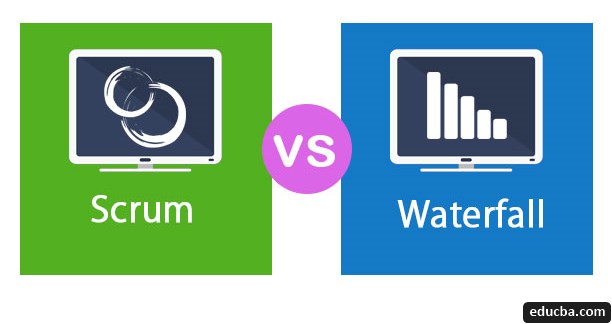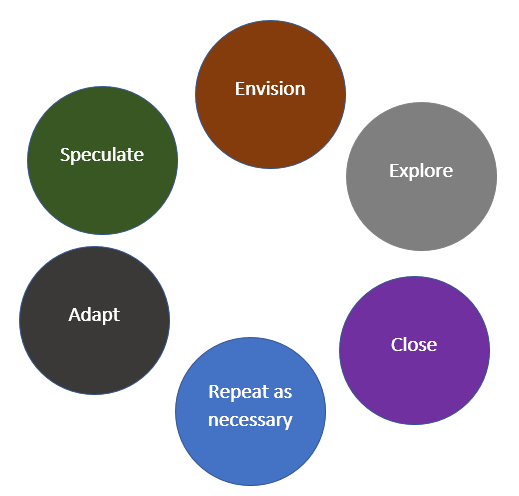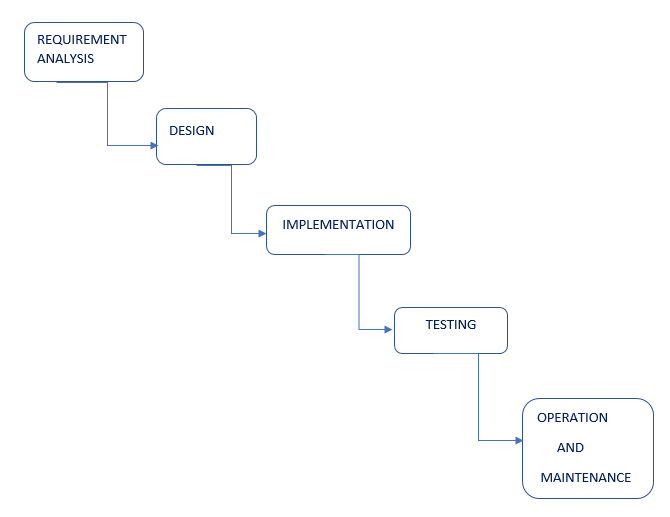
Difference between Scrum vs Waterfall
The development of computer software and process system has always been done by several methodologies. Methodologies use different frameworks to design, manage and control the development process. Software development life cycle or SDLC consists of phases for planning, analysis, design, and implementation. SDLC process comprises of a well-planned strategy to modify or create a new product. There are many approaches SDLC use to develop the software, waterfall and agile(scrum) development are among the popular development approaches. Scrum is considered the best approach for difficult projects. In this topic, we are going to learn about Scrum vs Waterfall.
Waterfall: The waterfall development model or traditional software development life cycle. Its working approach is linear and sequential, it completes one activity before starting the other activity. Waterfall’s working style break up the work into the requirement, analysis, design, coding and testing, and term that phases.
Scrum: This is a member of the agile family. Scrum puts the focus on the management and development of the project. The scrum process is used to manage, develop, and deliver the project on time. Scrum works best for complex projects and innovative solutions are delivered.
Head To Head Comparison Between Scrum vs Waterfall (Infographics)
Below is the top 12 comparison between Scrum vs Waterfall:
Key Differences in using Waterfall vs Scrum SDLC
Let us discuss some of the major differences between Waterfall vs Scrum SDLC:
Waterfall model
- When the requirements from the product are clear and have a picture of the result.
- The customer is very clear, and the requirements are well defined and understood, does not require changes.
- The concern all is about the final product, time is not concerned. Defined schedule and budget are given by the customer.
- The waterfall model works best when there is less or minimal involvement of the customer.
Scrum
- The scrum process can be used when the requirements from the software are not well defined.
- When changes are required at any phase of the development. it can implement changes at a very low cost at any stage during development.
- When the freedom to take a decision is needed by the developer and the stakeholders. Options are provided to them so that they can take decisions independently. No fear of failure
Comparison table between Scrum vs Waterfall
To understand more clearly about both development processes, we can make a Comparison within slots.
| Scrum SDLC | Waterfall SDLC |
| It includes customers and stakeholders at each phase. | This keeps the customer at bay. By the time the result is near. |
| Scrum development saves time and money by reviewing regular sprints in the development process. | It may take extra time as reviewing is done at the result only, if found inappropriate then the process is back to level 1. |
| Work is divided into teams as an individual responsibility. | Work is divided into phases. The team works closely. |
| Scrum takes feedback from the product owner and stakeholders. The customer is kept in the loop and constantly taken his word throughout the process of development. | The required documentation is done at the initial stage. Proper documentation takes place during the requirement phase only. |
| The Scrum development process works well for difficult and complex projects. | The waterfall model works well with smaller projects. |
| It has no defined stages. | The waterfall model has clear and defined stages to work on the project. |
| Scrum welcomes changes at an early and late-stage during development. | It welcomes changes only at the requirement phase. There is not the liberty of making changes at later stages. |
| The development process is divided among the team as an individual, it does not wait for the previous stage to get completed. | Phases and processes are completed one at a time. |
| It divides its work into sprints and then assigned according to team members. | It divides its work into stages and the process continues one after the other. |
| Working software is shown to the customer at an early stage. This is why changes are welcomed. | Working software is produced at the delivery time only to the customer. |
| It is not bound by a tight deadline. The customer also not rushing for the software as he is aware of every movement or development taking place for his product. | The waterfall development process is bound with a tight deadline. |
| The customer is kept informed about every step taking place in project development. | The customer will contact only at the delivery date. |
Differences of Scrum vs Waterfall
Fig. waterfall Model phases.
Fig. Scrum SDLC
Waterfall model
- Waterfall SDLC provides a defined structure for working and controlling a software development process.
- Architectural and design details and errors with it are noticed at the initial stage and are kept under documentation properly, to save time during the development.
- At the requirement phase, the proper team sits with the customer, and note down the requirements, know what exactly the customer is expecting from the software. Documentation is all that team follows throughout the development process.
- It can keep a record of the time and cost accurately if the process is followed sincerely.
- The waterfall model is sequential and linear in nature, so it is easier to detect the faults of one phase before moving to the next stage.
Scrum practice
- This is the best development approach for the larger projects, it works by dividing the work into smaller sprints(cycle).
- The working efforts of the team member can be measured as it is transparent. It can be appreciated individually.
- It saves time because the chances of errors are less, it involves customers and stakeholders at each phase of development.
- Scrum provides flexibility for changes in the product during any stage, this is because the development is coded and tested at every phase.
- The customer will be able to see the working software before the final delivery.
- Planning is just kept simple which makes the process easy to manage and flexible.
- Constant communication and interaction with the customer are priorities over the process and tools.
Requirements initials difference
| Waterfall | Scrum |
| Documentation is larger. | Not defined documentation, small index cards are preferred. |
| Documentation is formal and done through proper analysis. | It focuses on conversation and based on that create the story and use it for creating the product. |
| Documentation is done by a professional business analyst. | The product owner does informal requirements discussion. |
| Documentation is completed before starting any development process. | Requirements are completed only when the product takes its final touch. |
Conclusion
Both waterfall and scrum software development life cycle is a good approach. The benefits through these can be taken out only by the initial stage of analyzing the need from the product, for example, the size of the product can let the manager decide which approach can be chosen for the development of the software. The below table shows the difference in choosing the approach.
Recommended Articles
This has been a guide to the top difference between Scrum vs Waterfall. Here we also discuss the Scrum vs Waterfall key differences with infographics and a comparison table. You may also have a look at the following articles to learn more –




